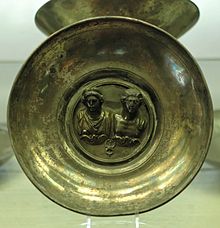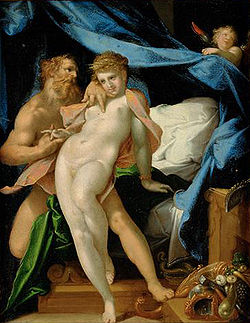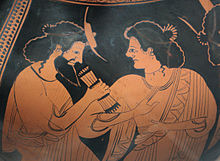- Maia (mythology)
-
In Greek mythology, Maia[1] (
 /ˈmeɪ.ə/ or /ˈmaɪ.ə/; Greek: Μαῖα; Latin: Maia) is one of the Pleiades and the mother of Hermes. The goddess known as Maia among the Romans may have originated independently, but attracted the myths of Greek Maia because the two figures shared the same name.
/ˈmeɪ.ə/ or /ˈmaɪ.ə/; Greek: Μαῖα; Latin: Maia) is one of the Pleiades and the mother of Hermes. The goddess known as Maia among the Romans may have originated independently, but attracted the myths of Greek Maia because the two figures shared the same name.Contents
Birth
Maia is the daughter of Atlas[2] and Pleione the Oceanid,[3] and is the eldest of the seven Pleiades.[4] They were born on Mount Cyllene in Arcadia,[5] and are sometimes called mountain nymphs, oreads; Simonides of Ceos sang of "mountain Maia" (Maia oureias) "of the lovely black eyes."[6] Because they were daughters of Atlas, they were also called the Atlantides.[7]
Mother of Hermes
According to the Homeric Hymn to Hermes, Zeus in the dead of night secretly begot Hermes upon Maia, who avoided the company of the gods, in a cave of Cyllene. After giving birth to the baby, Maia wrapped him in blankets and went to sleep. The rapidly-maturing infant Hermes crawled away to Thessaly, where by nightfall of his first day he stole some of his brother Apollo's cattle and invented the lyre from a tortoise shell. Maia refused to believe Apollo when he claimed Hermes was the thief and Zeus then sided with Apollo. Finally, Apollo exchanged the cattle for the lyre, which became one of his identifying attributes.
As nurturer
Maia also raised the infant Arcas, the birth child of Callisto with Zeus. Wronged by the love affair, Zeus's wife Hera in a jealous rage had transformed Callisto into a bear. Arcas is the eponym of Arcadia, where Maia was born.[8] The story of Callisto and Arcas, like that of the Pleiades, is an aition for a star formation, the constellations Ursa Major and Ursa Minor, the Great and Little Bear.
Her name is related to μαῖα (maia), an honorific term for older women related to μήτηρ (mētēr) 'mother'.[citation needed] Maia also meant "midwife" in Greek.[9]
Roman Maia
 Mercury and Maia[10] inside a silver cup dedicated by the freedman P. Aelius Eutychus (late 2nd century AD), from a Gallo-Roman religious site
Mercury and Maia[10] inside a silver cup dedicated by the freedman P. Aelius Eutychus (late 2nd century AD), from a Gallo-Roman religious site
In ancient Roman religion and myth, Maia embodied the concept of growth,[11] as her name was thought to be related to the comparative adjective maius, maior, "larger, greater." Originally, she may have been a homonym independent of the Greek Maia, whose myths she absorbed through the Hellenization of Latin literature and culture.[12] In an archaic Roman prayer,[13] she appears as an attribute of Vulcan, in an invocational list of male deities paired with female abstractions representing some aspect of their functionality. She was explicitly identified with Earth (Terra, the Roman counterpart of Gaia) and the Good Goddess (Bona Dea) in at least one tradition.[14] Her identity became theologically intertwined also with the goddesses Fauna, Magna Mater ("Great Goddess", referring to the Roman form of Cybele but also a cult title for Maia), Ops, Juno, and Carna, as discussed at some length by the late antiquarian writer Macrobius,[15] probably under the influence of the 1st-century BC scholar Varro, who tended to resolve a great number of goddesses into one original "Terra."[16] The association with Juno, whose Etruscan counterpart was Uni, is suggested again by the inscription Uni Mae on the Piacenza Liver.[17]
The month of May (Latin Maius) was supposedly named for Maia, though ancient etymologists also connected it to the maiores, "ancestors," again from the adjective maius, maior, meaning those who are "greater" in terms of generational precedence. On the first day of May, the Lares Praestites were honored as protectors of the city,[18] and the flamen of Vulcan sacrificed a pregnant sow to Maia, a customary offering to an earth goddess[19] that reiterates the link between Vulcan and Maia in the archaic prayer formula. In Roman myth, Mercury (Hermes), the son of Maia, was the father of the twin Lares, a genealogy that sheds light on the collocation of ceremonies on the May Kalends.[20] On May 15, the Ides, Mercury was honored as a patron of merchants and increaser of profit (through an etymological connection with merx, merces, "goods, merchandise"), another possible connection with Maia his mother as a goddess who promoted growth.[21]
See also
References
- ^ The alternate spelling Maja represents the intervocalic i as j, pronounced similarly to an initial y in English; hence Latin maior, "greater," in English became "major."
- ^ Hesiod, Theogony 938.
- ^ Pseudo-Apollodorus, Bibliotheke 3.10.1.
- ^ Bibliotheke 3.10.2; Aratus, Phainomena 255–263. Maia is the only one of the Pleiades named by these two sources to appear also in the rather idiosyncratic list given by the Scholiast to Theocritus (13.25), who says they were the daughters of the Amazons; see the note of J.G. Frazer in his 1921 Loeb Classical Library edition and translation of what was then assumed to be the Library of Apollodorus, vol. 2, p. 2.
- ^ Bibliotheke 3.10.1.
- ^ Simonides, Fragment 555.
- ^ Diodorus Siculus 3.60.4.
- ^ Bibliotheke 3.101.
- ^ Vivian Nutton, Ancient Medicine (Routledge, 2004), p. 101.
- ^ Although the identification of Mercury is secure, based on the presence of the caduceus, the one-shouldered garment called the chlamys, and his winged head, the female figure has been identified variously. The cup is part of the Berthouville Treasure, found within a Gallo-Roman temple precinct; see Lise Vogel, The Column of Antoninus Pius, Loeb Classical Library Monograph (Harvard University Press, 1973), pp. 79–80, and Martin Henig, Religion in Roman Britain, (Taylor & Francis, 1984, 2005), pp. 119–120. In Gaul, Mercury's regular consort is one of the Celtic goddesses, usually Rosmerta. The consort on the cup has also been identified as Venus by M. Chabouillet, Catalogue général et raisonné des camées et pierres gravées de la Bibliothéque Impériale (Paris, 1858), p. 449. Maia is suggested by the concomitant discovery of a silver bust, not always considered part of the hoard proper but more securely identified as Maia and connected to Rosmerta; see E. Babelon, Revue archéologique 24 (1914) 182–190, as summarized in American Journal of Archaeology 19 (1915), p. 485.
- ^ Robert Turcan, The Gods of Ancient Rome: Religion in Everyday Life from Archaic to Imperial Times (Routledge, 2001), p. 70.
- ^ Pierre Grimal, The Dictionary of Classical Mythology (Blackwell, 1996, originally published in French 1951), p. 270.
- ^ Preserved by Aulus Gellius, Attic Nights 13.10.2.
- ^ By Cornelius Labeo, as recorded by Macrobius, 1.12.20; H.H.J. Brouwer, Bona Dea: The Sources and a Description of the Cult (Brill, 1989), pp. 232, 354.
- ^ Macrobius, Saturnalia 1.12.16–33.
- ^ Brouwer, Bona Dea, p. 354.
- ^ In Mario Torelli's diagram of this haruspicial object, the names Uni and Mae appear together in a cell on the edge of the liver; see Nancy Thompson de Grummond, Etruscan Myth, Sacred History, and Legend (University of Pennsylvania Museum of Archaeology, 2006), p. 44 online.
- ^ Ovid, Fasti v.73; Turcan, The Gods of Ancient Rome, p. 70.
- ^ Macrobius, Saturnalia 1.12.20; Juvenal, Satires ii.86; Festus 68.
- ^ T.P. Wiseman, Remus: A Roman Myth (Cambridge University Press, 1995), p. 71.
- ^ Turcan, The Gods of Ancient Rome, pp. 70–71.
Bibliography
- Grimal, Pierre, The Dictionary of Classical Mythology, Wiley-Blackwell, 1996, ISBN 9780631201021. "Maia" p. 270
- Harry Thurston Peck, Harper's Dictionary of Classical Antiquities, 1898
- Smith, William; Dictionary of Greek and Roman Biography and Mythology, London (1873). "Maia"
- Encyclopædia Britannica, 1911.
External links
Categories:- Greek mythology
- Roman mythology
- Greek goddesses
- Nature goddesses
- Divine women of Zeus
Wikimedia Foundation. 2010.


